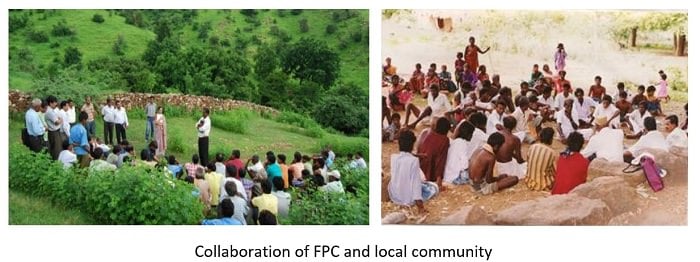Joint Forest Management – History
- The policies and guidelines of JFM were started in Indian National Forest Policy 1988 by central govt. to encourage people’s participation in forest management, protection and conservation
- As an outcome of the forest policy, JFM started in West Bengal’s Bakura district, where Ajit Banerjee, a silviculturist, was conducting his trails in the forest which were being disturbed by grazing and illegal harvesting by populace.
- He went against the suggestions of his co-workers went ahead and took the help of representative from 11 local villages and negotiated contract terms with adhoc Forest protection committee.
- It involved 612 families managing 7 sq km of degraded forest. 25% of the profit went to villagers.
- It became successful and was later expanded to other parts of the state as well
- In 1990, ministry of environment forest prepared a blueprint of JFM
- By 2001,out of 28 states , 25 came out with their own JFM programs
Objectives
- To protect forest
- To protect customary rights of people
- Cost effective conservation
- Meeting down community subsistence need
- To elicit active participation of villagers in (a) creation (b) management and (c) protection of plantations
- To conserve Biodiversity through people’s action
- To create and generate forest –based economy for the villagers
- To ensure effective coordination between state govt. and local people who are dependent on forests
Expected Outcomes
- Equal and sincere participation by people
- Ability to develop and implement collective decision-making
- Social fencing: community barrier to overgrazing and degradation.
- Empowerment of local govt
- Sharing of authority: between village community and forest dept.
- Protection of degraded forest : by villagers and in return get 25% of the forest share/produce
Institutional Hierarchy
- Forest Protection committee (FPC) – 2 members from each family (1 male and 1 female)
- Small executive village committee – villagers, local official, panchayat member and chairmanship of elected panchayat members. Local forester is the secretary of the committee.
- Memorandum of understanding is signed between local forest committee and forest dept.
- A micro-plan is prepared jointly – incorporates the measures and works that would be undertaken to manage the forest for generally 10 yrs. of projection time
Activities
- Afforestation
- Prevention of cutting forest
- Pasture land
Shortcomings
- JFM guidelines does not contain attitudinal changes organisation concerned with implementation of JFM policies.
- No active involvement from the local community
- Conflict between interest of diff policies , Forest Right Act 1926 , Forest Conservation Act 1980 and 1988
- Division of political entity in caste, ethnic group and religion.
Case Study – Gorela Village
- Gorela village is located in the Girwa Block, at a distance of 10 Km from the city of Udaipur in Rajasthan. It is home to 230 families
- Predominant communities here are Gujjars- land owning community, Gametis-either landless or have very small holdings and Rajputs
- On discussion with the villagers and forest department officials about the evolution of forest protection system and management practices , issues came out in 3 time periods – before 1970,during 1970’s and after 1980.

History of the forest
- The history goes back to raced back to 1947 when the then Maharana had given rights to the village to graze their cattle and collect fallen wood and grass in return for a fee called “lagan”. Later on the fee was collected by the Forest dept (FD).
- People collected amla, gum, fodder, babool, neem etc. and also people were allowed to collect dead and fallen wood and graze their animals in the forest.
- As part of the wildlife conservation drive, FD converted a part of the grazing land into Sajjangarh Wildlife Sanctuary
- As a result there was less land available to people to meet their fuel and fodder requirement.
- After 1972 famine, situation grew worse, and forced people to embark on a three stage process of forest cutting.
- The villagers approached the Forest department with their forest management problems.
Some objectives
- First, people suggested that abundantly growing Lantana camara – red sage ad white sage, that suppresses the growth of grass in the area, should be removed.
- Second, people suggested that Prosopis julliflora should be eradicated because it does not allow other species to grow
- Third, thorny Ber bushes are growing in many patches in this area. Villagers want these to be pruned because they hamper grass collection and growth.
- Fourth, villagers feel that grass productivity is likely to decline in the future because of closing crown cover.
Expected Outcomes
- People suggested that branch cutting and pruning on regular basis would ensure that trees grow only in height and grass can grow uninhibited.
- These pruned branches can be used as fuel wood and fodder.
INSTITUTIONAL HIERARCHY in Gorela Village
- The Gorela Village Forest Protection and Management Committee –formed in July 1992 , 117 members
- Formation of Executive committee – village patwari, a forester and 15 persons from the VFPMC.
- Memorandum of understanding was signed between local forest committee and forest dept
- Forest protection-was undertaken on a rotation basis by two community appointed watchmen and VFPMC was responsible for organising regular patrols of the area by members on a rotational basis.
- Village problems and forest protection matters are discussed in meetings of VFPMC that happened 7 times in 1994.
- The VFPMC had conventional powers to detain anyone caught breaking rules and may impose fines and also villagers even resorted to a social boycott of the person who has broken rules
Author Bio: Vibhuti Raina is a 2nd Year B.Planning Student at School of Planning & Architecture, New Delhi.
References
- Joint Forest Management in India: An Unavoidable and Conflicting Common Property Regime in Natural Resource Management – Anuradha Vemuri
- Class notes – Papiya B. Raut
- https://en.wikipedia.org/wiki/Joint_Forest_Management
- http://www.naeb.nic.in/Reports/jfm.pdf